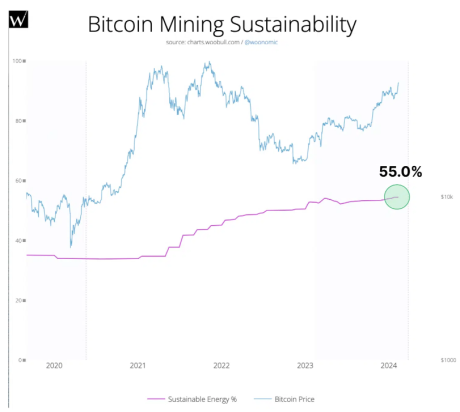Bitcoin, the enigmatic cryptocurrency known for its volatile price swings and digital gold status, makes a surprising choice for a new title: sustainability champion.
This is evident from a recent analysis by Bitcoin environmental impact expert Daniel Batten a notable increase in the use of renewable energy for mining, by a staggering 55%. This marks a significant shift from just four years ago, when the figure remained below 40%, and paints a picture of an industry undergoing a green makeover.
From carbon creator to clean crusader?
Bitcoins mining process, essential for creating new currencies, has historically been a lightning rod for environmental criticism. The enormous computing power required for this consumes enormous amounts of electricity, often derived from fossil fuels. This led to accusations that Bitcoin is a climate villain, emitting greenhouse gases and contributing to global warming.
However, the story evolves. Companies like Luxor Technology are tapping into Ethiopia’s hydroelectric wealth, while Argentina’s Unblock Global is recycling wasted natural gas from oil reserves.

Even domestic players like CleanSpark are upping their game with low-carbon solutions. These efforts, coupled with an overall decline in the intensity of mining emissions, indicate a genuine commitment to going green.
The Green Rush: Challenges and Warnings
Despite the positive progress, the sustainability of Bitcoin is far from over. The ever-expanding grid requires more energy, and it is crucial that there are enough renewable sources to keep pace.
Bitcoin market cap currently at $1.014 trillion. Chart: TradingView.com
Moreover, the impact on the environment extends beyond just energy consumption. The mountains of discarded mining hardware raise concerns about e-waste, a new hurdle on the path to true sustainability.
The future: a doubling of green
The success of Bitcoin’s green bet depends on several factors. Continued investment in renewable energy infrastructure is critical, and regulatory frameworks that encourage sustainable practices could play a crucial role.
Ultimately, the industry must demonstrate a long-term commitment to environmental responsibility, going beyond individual success stories to ensure widespread adoption of green solutions.
While the jury is still out on whether Bitcoin can truly shed its carbon-intensive past, the recent rise in renewable energy use is a promising sign. This green gamble, if played with transparency, scalability, and a holistic approach to sustainability, could pave the way for a future where Bitcoin and the environment coexist in harmony.
The question remains: will Bitcoin’s green hand win the game, or will it collapse under the weight of its own growth and environmental problems? Only time and industry commitment will tell.
Featured image by Karolina Grabowska/Pexels, chart from TradingView
Disclaimer: The article is for educational purposes only. It does not represent NewsBTC’s views on buying, selling or holding investments and of course investing involves risks. You are advised to conduct your own research before making any investment decisions. Use the information on this website entirely at your own risk.

